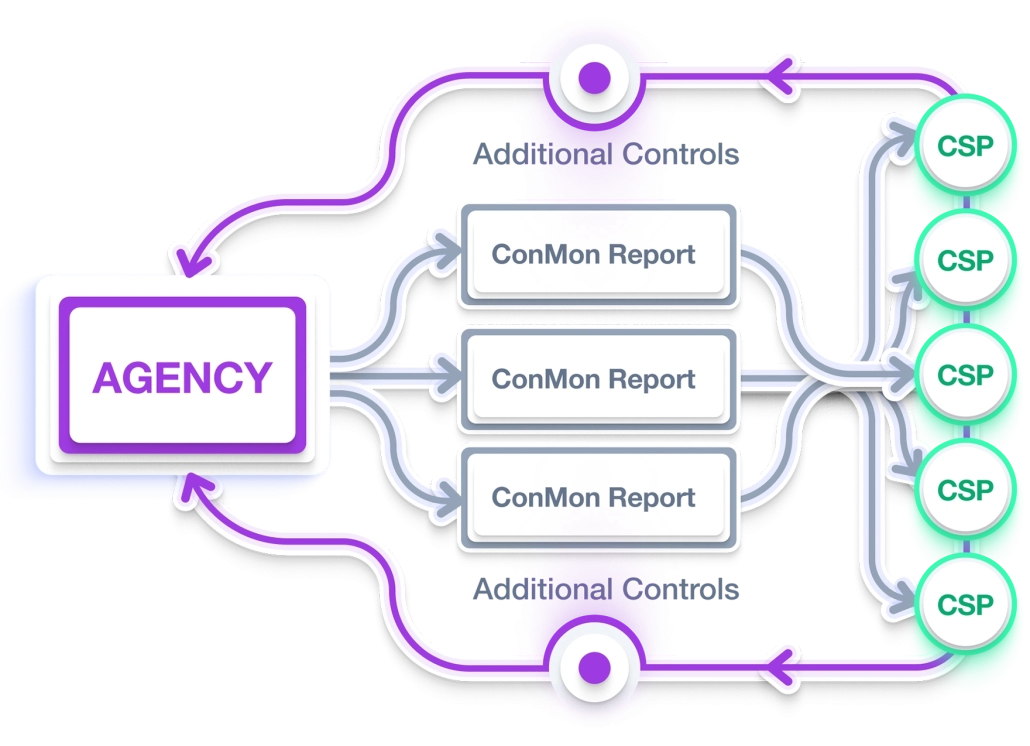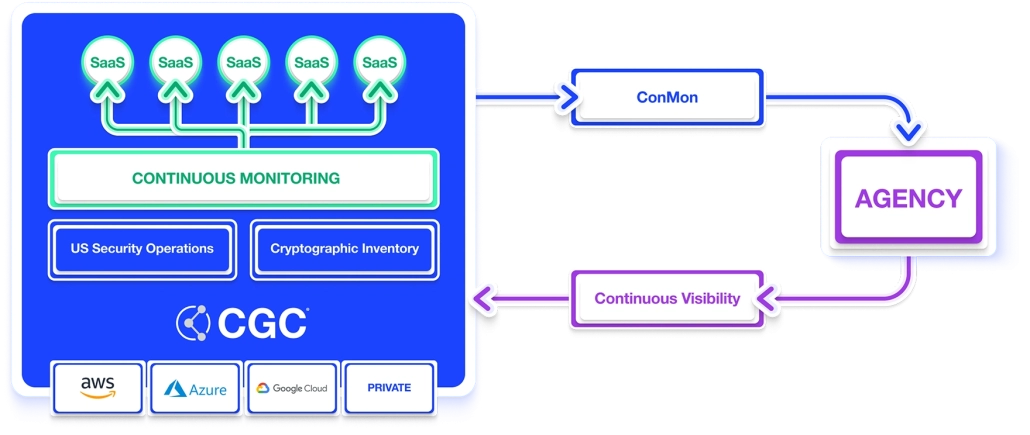Federal cloud compliance is undergoing significant transformation as FedRAMP faces its largest restructuring since it was created. This document examines the evolution of federal cloud security requirements, analyzes emerging changes to FedRAMP, and explores their implications for technology providers. As the compliance landscape becomes more fragmented, organizations face increasing costs and complexity. CGC offers a compliance acceleration platform that reduces these burdens, lowering compliance costs by up to 60%, decreasing time-to-market by 75%, and providing enhanced security while insulating partners from evolving agency-specific requirements.
Historical Context
- Before FedRAMP, federal cloud compliance was governed by FISMA (Federal Information Security Management Act), which applied NIST standards to technology workloads managing government data. Under this framework, federal agency Authorizing Officials (AOs) reviewed system security plans and monitoring artifacts to make risk-based decisions about granting Authority to Operate (ATO).
- While some reciprocity existed between agencies, the same technology often required different System Security Plans (SSPs) and controls across various agency deployments. This inconsistency created significant challenges when cloud platforms and SaaS technologies emerged in the early 2000s. The application of FISMA to these new technologies limited the adoption of innovative cloud solutions across government and favored legacy incumbents.
- In response, the Obama administration adopted a “cloud first” policy in early 2011 to drive government IT modernization and align with commercial best practices. The Office of Management and Budget (OMB) created FedRAMP (Federal Risk and Authorization Management Program) as part of this initiative in order to help serve as a centralized hub for authorizations that could be used across agencies. The program grew steadily over the following decade, culminating in its codification into law through the FedRAMP Authorization Act in the FY2023 National Defense Authorization Act.
Challenges of the FedRAMP Process
Despite its intent and growth, the FedRAMP process has presented significant challenges for cloud-native technologies. Many found the process arduous and sometimes arbitrary—complaints that were not unfounded. Particularly problematic were:
- The requirement for an agency sponsor
- The need for thousands of pages of documentation
- An average process time exceeding two years
- Costs of several million dollars before any revenue was received
Current State and Future Outlook
Today, FedRAMP is undergoing its largest restructuring since 2011 as part of broader changes in the US government. While we cannot predict the future with certainty, we can anticipate potential changes based on historical patterns.
Implications of These Changes
The burden of risk assessment and mitigation will move to individual authorizing officials across federal agencies. From an ISV’s perspective, this likely means a potential lack of “harmony” across ATOs, potentially requiring multiple versions of SSPs and unique controls per agency. As FedRAMP evolves and potentially becomes more of a certification, we expect to see agency authorizing officials have different interpretations of each certification, leading to ISVs not having a clear standard that they need to meet. Instead, the goal posts will potentially move continually, making the investment in compliance difficult to forecast and dealing with the government riskier.
As illustrated in the accompanying graphic, the complexity for ISVs scales quickly and, counterintuitively, gets worse the more successful they are in selling to government buyers.
Broader Impact Beyond Federal Government
The implications extend beyond FedRAMP and federal sales. While commercial SaaS providers have long pursued commercial compliance certifications (SOC2, ISO, HITRUST), FedRAMP has been the gold standard. Financial and telecommunications companies, for example, often request FedRAMP-authorized versions of SaaS products or, in their absence, insist on self-hosted deployments within their own infrastructure.
For ISVs targeting highly-regulated Fortune 2000 companies, costs scale dramatically when each buyer insists on self-hosting while demanding feature parity with commercial SaaS versions. The potential fragmentation of compliance standards could further complicate this landscape.
CGC: Future-proofing Your Government SaaS Strategy
While specific changes remain uncertain, significant transformation is inevitable and likely to continue into the foreseeable future. Organizations must prepare for a more complex compliance environment where the harmonization previously offered by FedRAMP may be diminished. This evolving landscape will require adaptive strategies from technology providers to maintain access to this dynamic market.
CGC’s compliance acceleration platform is uniquely positioned to help. CGC not only accelerates compliance with NIST standards (800-53), it insulates our partners from many of the complexities of working directly with US government agencies. As illustrated in the accompanying graphic, CGC acts as a compliance, reporting, and risk insulation layer between cloud-native ISVs and US government agencies.
The CGC Value Proposition
CGC’s compliance acceleration platform offers a compelling return on investment for ISVs entering the government market:
Financial Benefits:
- Reduces compliance costs by up to 60% compared to in-house implementation
- Decreases time-to-market from 24+ months to 6 months on average
- Eliminates upfront capital expenditure for compliance infrastructure
- Converts unpredictable compliance costs into predictable operational expenses
- Avoids expensive remediation costs from failed compliance audits
Operational Advantages:
- Provides access to specialized compliance expertise without hiring FTEs
- Streamlines documentation processes, reducing burden by approximately 75%
- Enables faster expansion to additional agencies by leveraging existing controls
- Simplifies the management of multiple agency-specific requirements through a single interface
- Provides managed security operations
Risk Mitigation:
- Insulates ISVs from evolving agency-specific requirements and interpretations
- Provides superior security posture through enterprise-grade controls
- Significantly reduces the likelihood of security incidents through advanced monitoring
- Protects against compliance standard shifts through adaptive control frameworks
In much the same way that a government reseller or channel partner insulates ISVs from arduous government contract flow-downs, CGC insulates ISVs from complex compliance and cyber requirements across their customer base. But CGC is not just an insulator, it also provides a level of compliance and cybersecurity that is difficult to achieve by any individual ISV. AOs are going to be more risk-averse than ever (especially once there is an inevitable breach) and will likely layer in increasing requirements for controls and operational security, meaning tools and people. Because CGC is a platform used by many ISVs, it can spread these investments over multiple companies, providing superior cybersecurity at lower costs than an ISV could provide on its own. This same risk aversion will lead to “lowest common denominator” requirements, such as “US citizen on US soil” operations and support—something that CGC has done from day one.
Government Need for ISV Innovation is Greater Than Ever
Change is constant even if its intensity is not. Adversarial hacking will continue and likely grow, especially as the US government downsizes and needs to rely on technology to meet mission goals. ISVs will need to consider their entry into the US government market more deeply than ever, understanding risks and insuring against them.
In light of these conditions, the value of a platform that mitigates risk and makes costs predictable is higher than ever. CGC is uniquely positioned to be the “Market entry and acceleration” platform of choice for ISVs pursuing US government contracts. CGC’s Origins Program eliminates the complexity and removes the guesswork for ISVs pursuing the government market.




